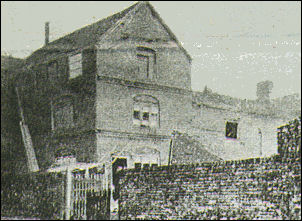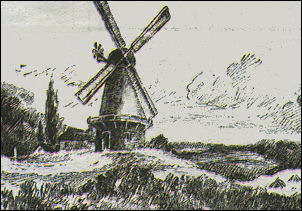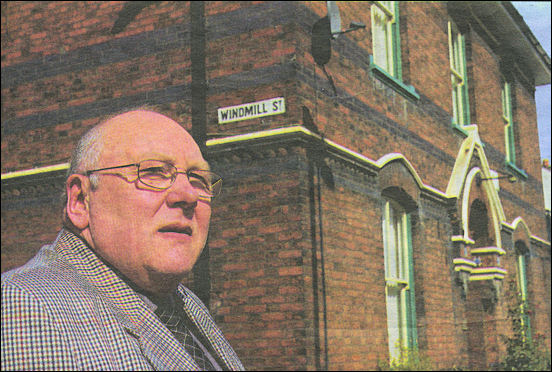|
Ladywell, Tunstall
- 'a town of courts, wells and windmills'
  
click the
"contents" button to get back to the main index & map
next: Adams & Ggreengates
previous: Brownhills & Dr Oliver
|
Historian Fred Hughes
writes....
The road
to Tunstall from Brownhills leads through St Mary’s and Ladywell areas of
Tunstall, the most northern of the Six Towns.
“The
Sneyd’s were the owners of 1,250 acres of land in the manor of Tunstall
in the 18th century,” says historian Steve Birks. “However, only a
relatively small part of this was situated inside the town indicating
the extent of the parish. The Sneyd holdings were mainly Holly Wall Farm
and Tunstall Farm.”
Tunstall
Farm was later owned by Mary Younge with land on the east side of it owned
by the Smith-Child’s of Newfield Hall. Later, seven acres were sold to the
Williamson brothers where Goldendale Ironworks was built. Some of this was
divided to make Tunstall cemetery in 1868.
“The
Manor itself can be dated from 16th century covering among others Chell,
Oldcott, Wolstanton and Burslem,” continues Steve. “But the court sat here
from 1274 until Tudor times when it was held elsewhere in the manor until
it finally closed in the middle of the 18th century.”
|
The
original Tunstall court house stood in Cross Street renamed Oldcourt
Street in the 1950’s. According to some records it was demolished in 1888.
“There
are some inaccuracies that may not be resolved,” says Tunstall author
Don Henshall. “It has been suggested for instance that the old Fryar’s
Pottery at the corner of Oldcourt Street and Roundwell Street may have
been the court house. Victorian-styled architecture dispels that. But it
is possible it might have stood on this site.”

Tunstall manor court leet
A lot has
changed in Tunstall over recent times, and continues to change. Although
the court goes back centuries the town itself isn’t that old.
“It was
established to serve manorial business,” continues Don. “Population was
sparse and fragmented and the location must have been convenient for the
overseers of the estates. In 1810 for instance there were just over
fifteen-hundred inhabitants many of whom arrived with the canal and
industry. Twenty years later the population had risen to 3,673, and in
1851 it was a bustling 9,500.” |
A
subsequent courthouse and market was built in Tower Square as it is now
known. Steve Birks points out other elements of the court’s
jurisdiction.
“The
court was responsible for the upkeep of the pinfold to impound stray
animals, a common occurrence in earlier times,” adds Steve. “In 1782 the
pinfold stood at the junction of Furlong Lane and High Street. Later it
moved to the west end of Clayhills Road. The official responsible for
this was called a pinner, chosen at the court leet.”
What is
the court leet, I ask.
“It was
an historical court in England and Wales,” answers Steve. “In medieval
England the Lord of the Manor exercised certain jurisdictional
franchises. The most important of these was the frankpledge and it’s
policing. A court leet was a court of record whose duty was not only to
view the pledges but to try offenders in jury courts. Here a town
steward acted as judge with administration activity executed by a
bailiff. The courts leet fell away on the arrival of magistrate’s
courts.”
|
Tunstall was also noted also for its market with a windmill standing
on high ground in Pierce Street near Jefferson Street.

a sketch of the old Tunstall windmill
“These
names have been changed, they were formerly Windmill and Cooper Street,”
says Don. “And it’s an area prominent for its spring wells that stood
beneath dozens of criss-crossing terraced streets which were demolished in
the 1980’s.”
At the
town end of Pierce Street an imposing detached town house still has the
old ceramic street nameplate attached in defiance of modernisation.
“It was a
doctor’s house and surgery before my father Clement bought it some sixty
years ago,” says the owner Catholic funeral director Paul McGough. “When
the Scared Heart Church was being built the indomitable Father Ryan,
knowing my father worked for H&R Johnson as a carpenter, persuaded him to
make a coffin for a poor parishioner. At the next Sunday mass Father Ryan
announced that the town needed a Catholic undertaker and that my father
was setting up a funeral business. He couldn’t get out of it if he’d
wanted to.” |
The
McGough’s are a big Tunstall family founded by Paul’s
great-grandfather.
“Michael
Mcgeogh came to North Staffordshire from Carrick McCross in County
Monaghan,” explains Paul. “Apparently he was tramping through
Staffordshire from Liverpool when he took a rest on Yarlet Hill outside
Stafford. While he was saying his rosary something made him turn back. He
walked to Newcastle, took a job on a brick works and soon got married. One
of his children was my grandfather Peter who settled in Tunstall and was a
town councillor for forty-five years. He was a JP and a Papal Knight.”
The
McGough family are deeply committed to Tunstall and its prevalent Catholic
faith.
“Apparently my great-grandfather saw a crowd of people walking along the
road to Stafford one day,” recalls Paul. “He stopped them to ask where
they were going and they told him they were off to the gaol to make sure
they had a good view of the last public hanging. Michael remonstrated with
them and managed to persuade many of them to turn back.”

Don Henshall outside C McGough & Sons funeral directors in Tunstall
the old sign for Windmill Street remains on the wall
The house
at the end of Windmill Street has been lovingly preserved by the McGough
family. Its five reception rooms still have the original chair rails, 18
inch deep skirting boards and delightfully moulded plaster corbels lining
the arched door frames. The back rooms are separately defined as servant’s
quarters in a touch of period history.
“We found
wells when we renovated the yards,” says Paul. “But we capped them. The
old house stood in its own gardens. Then the terraces were built around
it. There were also stables and a hayloft in space we’ve converted for the
business.”
MacGough’s house lingers in a historic corner of Tunstall near where the
old court once stood. Hopefully it will remain undisturbed for many years
to come.
next week: Greengates, Tunstall
  
click the
"contents" button to get back to the main index & map
next: Adams & Ggreengates
previous: Brownhills & Dr Oliver
 see
more on Tunstall
see
more on Tunstall |